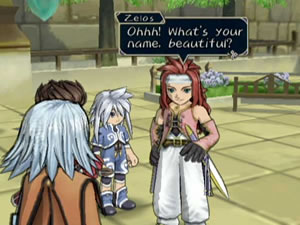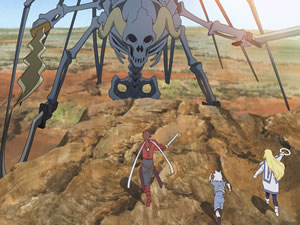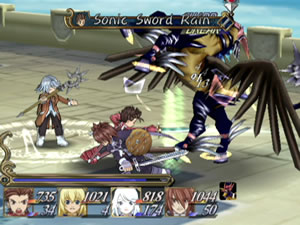A gamer’s tale.
You can’t judge a book by its cover, but you can come pretty close with video
games. Take, for example, a typical console RPG. You’ve got an underage hero
with big eyes, spiky hair and a large sword, a nagging but important female character
(usually a magic user) and the word ‘mana’ strewn about liberally. Mix it all
together with some sort of Armageddon plot and you’ve got Instant RPG. Just add
water, heat, and serve.
Namco’s latest, Tales of Symphonia, fits this stereotype like a glove. It’s got all the clichéd elements we’ve enjoyed for years, but manages to breathe some new life into the mix. In turn, Gamecube RPG fans can now breathe a collective sigh of relief.
Tales
of Symphonia is the latest in the Tales series, which has been popular for some time in Japan but only enjoying marginal notoriety in the U.S. thanks to Tales
of Destiny back in 1998. As most gamers aren’t really hip to the backstory, that kind of nerdy knowledge isn’t required for Tales
of Symphonia.
The world of Sylvarant is a simple place. It’s got quaint villages, happy little clouds and a bunch of bad dudes called Desians running human farms intended to bring about the destruction of the world. Maybe it isn’t so simple. In any case, the only thing standing between the citizens of Sylvarant and utter destruction is Colette, the Chosen of the goddess Martell. All she needs to do is unlock the seals to bring about the regeneration of the world and all will be fine and dandy. Natch.
Tales of Symphonia chronicles the adventures of Colette and an assortment of mercenaries and magic users on their quest to save the world. Okay, so it’s not the most original story, but at least the character development isn’t half bad and the dialogue makes sense. Mostly.
One of the first things that jumps out at you is Symphonia‘s cel-shaded visual style. Sure, the cel-shading craze has passed, but the game’s clean use of anime style characters in a 3D world seems to fit perfectly. The colors are bright, the lines are smooth and the overall visual experience is delivered well.
Traveling across the world map and dungeons are straightforward, efficient affairs.
Enemy groups are represented by various creatures or menacing blobs, which
can be attacked or avoided as necessary. Of course, avoiding too many encounters
will leave you without enough muscle to take out the bad guys that you won’t be able to avoid. Each region of the world also contains a “Guide Post,” which, when found, will enable Long-Range mode. This allows our heroes to cover long distances even faster at the cost of locating any secret items that may be hidden in the area. It’s much better than trudging from place to place, encountering insignificant, random enemies that only serve to waste time.
 It’s also worth mentioning that you can travel about the world freely. You’ll doubtlessly discover places that may not be accessible or relevant at the time, but you can pretty much go from one end of the world to the other from the very beginning of the game. It gives the world a continuity that many RPGs fail to offer.
It’s also worth mentioning that you can travel about the world freely. You’ll doubtlessly discover places that may not be accessible or relevant at the time, but you can pretty much go from one end of the world to the other from the very beginning of the game. It gives the world a continuity that many RPGs fail to offer.
When you’re not on the go, you’ll probably find yourself in the heat of battle. Symphonia‘s combat system is a fast-paced affair, acting in real-time as opposed to the traditional turn-based system employed by most Japanese RPGs. Just select an enemy and off you go, throwing out an assortment of attacks, advancing, retreating or blocking. Special attacks requiring Technical Points (TP) as well as magic are accessible through a set of customizable shortcuts, so you’ll always have a handful of super shots at your fingertips. Command strategies for your three AI-controlled teammates can be made on the fly, or if you’ve got a few friends around, you can plug in a few extra controllers and go into battle together.
Balancing your Technical points is one of the more essential skills you’ll need to master in order to be successful in combat. Naturally, more powerful spells and techniques require more points, but normal attacks will actually add to your point total. Furthermore, attacking together with your comrades will add to your unison meter. Filling up this meter will allow each of the heroes to make a concerted attack against an enemy without using any TP. On top of this, certain techniques together will result in an extra combo attack for even more damage. It all works together as a fun, solid system.
Alongside Symphonia‘s extensive list of potions and items are “raw materials” which can be given to special craftsmen in town to forge powerful, customized weapons. It is a little disappointing that you must provide certain materials for a specific weapon and cannot just offer up materials for a mystery item, but it’s nice to see the depth.
 Something that RPGs have been missing for a long time is the fine art of cooking. Even heroes have to eat, right? Symphonia solves this by including the mysterious “Wonder Chef,” an enigmatic cook who hides throughout the realm, sharing his secrets only to those who can find him. With his knowledge and a ton of groceries (found in both stores and from enemies), our heroes will be able to whip up tasty morsels to cure hurts and increase powers. Again, it would have been nice to be able to experiment with food items, but no luck.
Something that RPGs have been missing for a long time is the fine art of cooking. Even heroes have to eat, right? Symphonia solves this by including the mysterious “Wonder Chef,” an enigmatic cook who hides throughout the realm, sharing his secrets only to those who can find him. With his knowledge and a ton of groceries (found in both stores and from enemies), our heroes will be able to whip up tasty morsels to cure hurts and increase powers. Again, it would have been nice to be able to experiment with food items, but no luck.
Tales of Symphonia is an RPG that just doesn’t want to quit. The game spans two discs and claims over 80 hours of gameplay, and I’m not about to argue. Of course, the exact number of hours you spend depends on your style of play, but without a doubt, Symphonia is a game that goes the distance.
Unfortunately, even great length doesn’t entirely offset the boring story arc and occasionally frustrating gameplay. The game seems intent just sticking to the dungeon/town/dungeon theme and tossing one fantasy RPG cliché after another at you, which does grow a little tiresome. And the free roaming ability, while cool on paper, means you can easily wander into dungeons that are too tough and get wiped out.
But seeing as how it has been a while since the last RPG was released for the Gamecube, RPG fans should be pleased with Tales
of Symphonia, a solid example of the genre filled with all the elements you’d expect. It’s a tale you’ve heard before, but that doesn’t make it a bad one.







